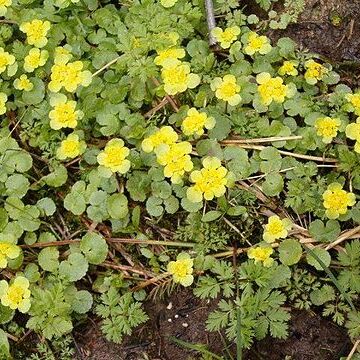Herbs, rhizomatous, stoloniferous, (rhizomes and stolons with functional leaves or stolon leaves reduced, nonfunctional, scalelike); caudex absent. Flowering stems repent, decumbent, or ascending to erect, leafy or leafless, (1.2-)2-30 cm (often as short as 2 cm in C. wrightii), glabrous or sparsely to densely villous. Leaves cauline or arising from stolons or rhizomes, opposite or alternate; stipules absent; petiole present, glabrous or villous; blade ovate, depressed-ovate, depressed-elliptic, reniform, flabellate, or, sometimes, nearly orbiculate, unlobed, base attenuate, cuneate, truncate, or cordate, ultimate margins subentire, crenate, crenulate, or crenate-dentate, crenae sometimes prominent and margins appearing ± lobed, apex obtuse, rounded, or truncate, surfaces glabrous or sparsely villous to villous; venation palmate. Inflorescences simple or compound cymes, from terminal bud in rosette, 2-30-flowered, sometimes flowers solitary, bracteate. Flowers: hypanthium 1/2-3/4 adnate medially or distally to ovary, 0.5-1.5 mm free from ovary, greenish or yellow-green; sepals 4, yellow, greenish yellow, green, greenish red, reddish orange, or purple, sometimes purple-spotted; petals absent; nectary disc conspicuous or apparently absent; stamens 2-8, usually 4 or 8; filaments lanceolate to narrowly oblong; ovary 1/2-3/4-inferior, 1-locular, carpels connate 3/4-4/5 their lengths; placentation parietal; styles 2; stigmas 2. Capsules (cuplike after dehiscence), 2-beaked (beaks divergent). Seeds dark brown or reddish brown, ellipsoid, ovoid, or spheroid, smooth. x = 11.
More
Herbs perennial, small, usually with stolons, bulbs, or bulbils. Leaves alternate or opposite, petiolate, exstipulate, simple. Inflorescence a cyme surrounded by bracteal leaves, rarely flower solitary. Hypanthium ± adnate to ovary. Sepals 4(or 5), imbricate in bud. Petals absent. Disc absent, obscure, or distinctly (4 or)8-lobed, sometimes surrounded by brown papillae. Stamens 4 or 8(or 10); filaments subulate; anthers 2-loculed, laterally dehiscent; pollen grains minute, 3-colporoidate, with fine reticulum. Carpels 2, usually connate proximally; ovary subsuperior, semi-inferior, or subinferior, 1-loculed; placentas 2, parietal; ovules many; styles 2, free; stigmas punctate. Fruit a capsule, with 2 subequal or distinctly unequal carpels. Seeds many, ovoid to ellipsoid, smooth, papillose, tuberculate, puberulous, sulcate, or other texture.
Fls perfect, regular, perigynous, 4-merous; sep spreading; pet none; stamens 4–8, inserted in the notches of an 8-lobed disk that nearly fills the center of the fl; filaments very short; carpels 2, united below into a unilocular ovary with 2 parietal placentas; styles protruding through the center of the disk, divergently curved; capsule 2-lobed, dehiscent across the top; inconspicuous, branching perennials with small, simple lvs, the fls small, terminal or in small terminal cymes, or appearing axillary by proliferation of the stem. 40, cool reg.

